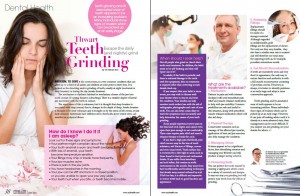 This article first appeared in the March 2015 issue of Ezyhealth magazine. We have reproduced it for the information of those of you who missed it when it was published.
This article first appeared in the March 2015 issue of Ezyhealth magazine. We have reproduced it for the information of those of you who missed it when it was published.
Bruxism, to give it the correct term, is a very common condition that can affect up to a third of all adults and children at some point in their lives. It is defined as the clenching and/or grinding of teeth, usually at night (nocturnal or sleep bruxism) or during the day (awake bruxism).
The mechanism is rhythmic habitual or involuntary closure of the jaw into tooth contact of varying duration (clenching). There is a variable degree of lateral jaw movement with the teeth in contact.
The exact cause of this is unknown, but it is thought that sleep bruxism is associated with sleep arousal, that is, changes on the depth of sleep. Awake bruxism is thought to be semi-voluntary and is brought on by the stress of life events, or just daily stressors. Individuals have different stress thresholds above which stress can manifest as a physical illness.
How do I know I do it if I am asleep?
Look out for these signs and symptoms:
- Your partner might complain about the noise.
- Your tooth enamel is worn and teeth become flattened.
- With loss of enamel, your teeth become temperature sensitive.
- Your fillings may chip or break more frequently.
- Your jaw muscles ache.
- There is pain in the jaw joints.
- You have headaches in the morning.
- Your jaw can be stiff and lock in a closed position, or you are unable to open your jaw very wide.
- Your teeth hurt when you bite, or teeth become mobile.
When should I seek help?
Not all people who grind or clench need treatment. In children the habit tends to be self- limiting and they will “grow out of it”.
In adults, if the habit is periodic and there is minimal damage to the teeth with few symptoms, then no treatment is required other than reviewing at each dental check-up.
If you suspect that your habit is more severe, you may wish to discuss with your dentist when to step in and treat the condition. Your dentist can help monitor tooth surface loss with the aid of radiographs, photographs and casts of your teeth. You can also keep a pain diary to track the symptoms more accurately and help determine the causes of your teeth grinding.
Some people experience severe pain in the head and neck region and cannot even open their jaws enough to eat comfortably. These cases require pain relief and muscle relaxant therapy to break the cycle.
If you have a high pain threshold, your chief concern may be the loss of tooth substance, fracture of fillings, crowns and even sound teeth. Tooth surface loss is worsened by a diet high in acids, such as those found in fruit juices and carbonated drinks. If you suffer from heartburn and acid reflux, this creates an acidic environment in the mouth. Stay away from hard toothbrushes and brushing techniques that abrade away enamel softened by acid. If left too late, it is difficult and expensive to restore teeth back to good function and appearance.
What are the treatments available?
1. Medication
Patients in pain and with trismus (lockjaw) will need immediate pain relief and muscle relaxant medication to help with jaw mobility. Common painkillers are safe and useful in this situation, along with prescribed muscle relaxant medication which will also aid sleep.
2. Physical Therapy
Conservative measures such as massage of the affected jaw muscles, application of heat and jaw exercises help manage the condition.
3. Managing Stress
If stress appears to be a significant factor, then identifying stressors and managing your lifestyle can help produce a longer lasting solution.
4. Protecting Teeth
You can protect the tooth enamel by wearing a nightguard, which comes in a variety of materials and designs. It may not stop you grinding, but will protect your teeth from the effects of grinding.
5. Replacement Fillings
Replacement fillings should be made of a stronger material. Although regarded as unfashionable, gold fillings are the replacement of choice. Not only are they very durable, they also have a similar wear rate to enamel and will therefore not wear away the opposing tooth as, for example, porcelain restorations would.
6. Full Mouth Reconstruction
If teeth are excessively worn and very short in appearance, the only way to restore function and aesthetics is with a full mouth reconstruction consisting of porcelain crowns. However, as always, it is better to identify problems at an early stage and adopt a more conservative approach.
Tooth grinding and its associated wear of teeth appears to be an increasing problem. Many individuals show signs of bruxism which can be picked up at an early stage. However, if one puts off seeking advice until it is already at a more advanced state, then management can be more difficult. If you suspect you are grinding, see your dentist for advice.
Dr. Steven Soo is a Dental Specialist in Prosthodontics with Specialist Dental Group®. He was formerly a Clinical Lecturer at the Eastman Dental Institute and Clinical Teacher at the GKT Dental Institute, both of which are affiliated with the University of London. Dr Soo has a special interest in prosthetic and implant restorative dentistry.






